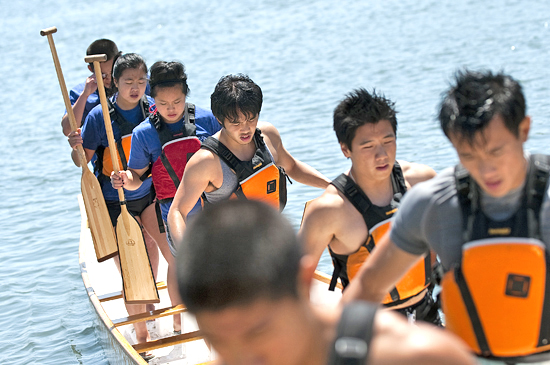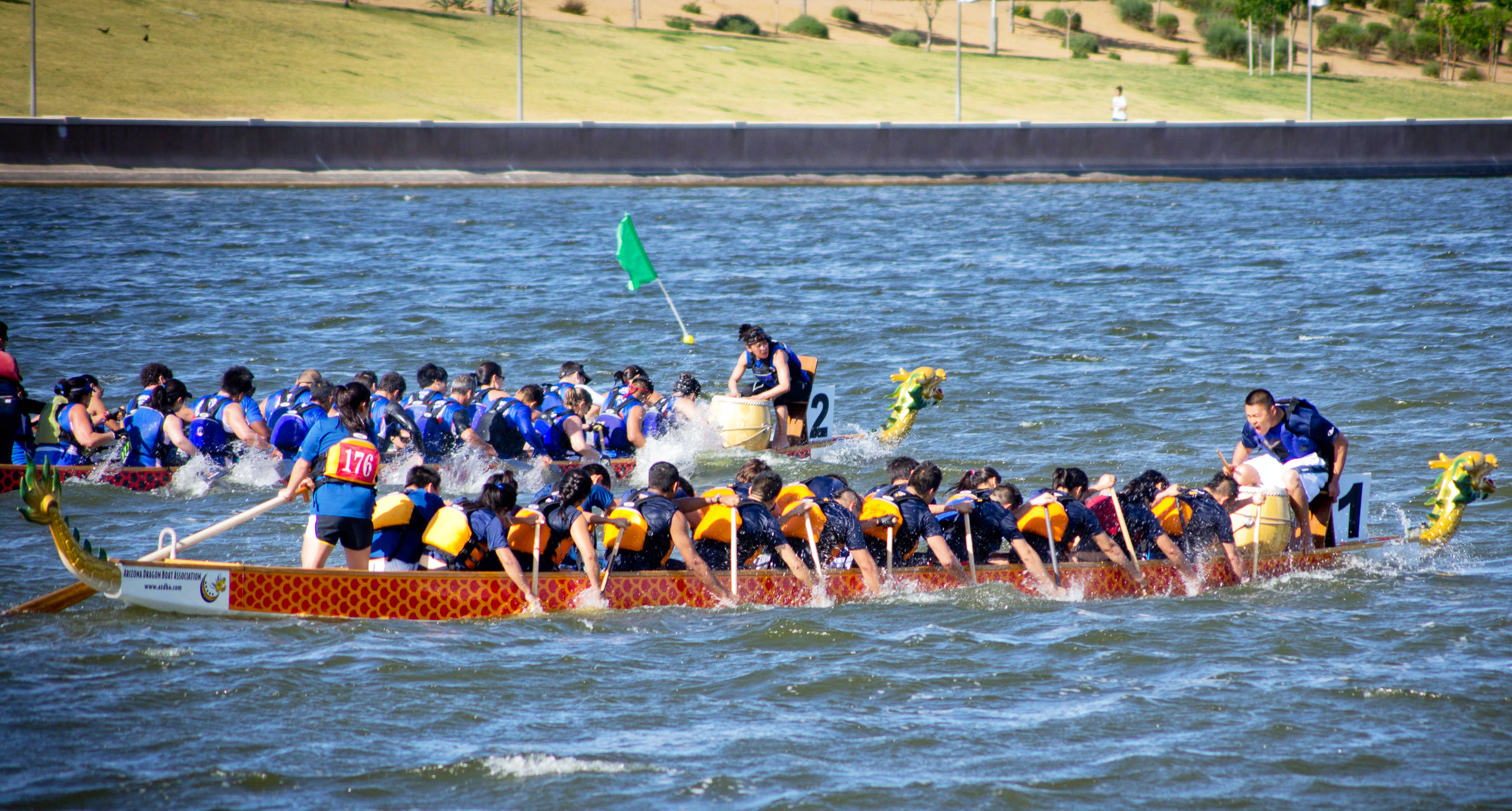
When new members first join dragon boat, they are assigned to the gold boat, where they can hone their skills and learn the ropes before advancing on to the more competitive blue boat.
Correction: The original version of this article contained an error. Only 0.07 seconds separated the crews’ finishes in Arizona’s finals.
Chris Koo fumbled for words in between chuckles when deliberating on the diet and attacks his paddling team would have, should the squad ever assume the form of its namesake.
“It eats at Covel, and it’d have some sort of blitzkrieg attack,” the UCLA dragon boat club vice president said with a smirk. “We have a blazingly fast start, one of the fastest starts in college,” Koo said of his team, whose quickness out of the gate may only be surpassed by the speed with which many of its 50-plus members siege dining halls after practice.
In terms of the hypothetical dragon’s form, Koo concluded that his paddlers would not resemble the archetypal fire-breathing, Western lizard-like embodiments of evil or the Eastern serpentine incarnates of regality.
“It’d be an ever-changing dragon. There are no guidelines for how the team is supposed to be,” said the fourth-year biochemistry student. “We’re constantly adapting to the world around us. … We never get pinned down with one specific technique. We want to question the sport (and) break down stroke.”
This adaptability in the myriad of training methods shows itself in the club’s dozen-plus hours of weekly practices and workouts. In the month leading up to quarterly races, when workouts intensify to simulate race-day exertion, practices include paddlers sprawling themselves on the ground of the John Wooden Center courtyard, as well as yelling expletives and groaning in unison as they move around frantically near Drake Stadium’s monkey bars.
Calisthenics, power lifts, sprints and chin-ups comprise just part of the training to move an 800-pound, dragon-shaped boat through a 500-meter sprint race.
While dragon boat’s approach to the sport and fitness is dynamic, the well-defined brotherly relationship between the wise, seasoned blue boat and the fiery, upstart gold boat serves as the constant at the heart of the program.
“Everybody comes in and starts on gold boat. On blue, you have the perspective that you know what it’s like to be on gold. Naturally, if you are a young person coming into the team, if there’s someone there to help you out and teach you stuff like how to paddle and go to the gym, it’s a great way to make (a) connection,” said Virginia Chu, a fourth-year molecular, cell and developmental biology student.
“It makes it so that you want to give that to the next generation of gold boats.”
Thuc-Vy Nguyen, who is in her first year on blue boat, believes that passion and understanding for the sport separates newcomers from veterans.
“Gold boat tends to be more vocally energetic, while blue boat is very goal-oriented. Being new to the sport, it’s really easy to get caught up in the social side of it,” the second-year English student said.
“I honestly didn’t really appreciate (the sport itself) until this summer.
“There’s this pressure on blue boat that you have to be a good role model. I want to be my best for (gold boat); you want to be the people they look up to,” Nguyen said.
First-year communication studies student Larry Yang recognizes that the blue boat provides the less-refined and experienced gold boat with a model.
“As (the gold boat crew), there’s a lot of energy and excitement because most of us are still really new to the sport. We don’t have these grand expectations for ourselves,” Yang said. “(We) try to be as good of people and paddlers as (blue boat is).”
First-year psychobiology student Christine Poon saw a bittersweet peak in admiration for her role models after the blue and gold crews respectively finished first and second this weekend at the 2012 Arizona Dragon Boat Festival’s 500-meter collegiate race. The competition marked the last for a few seniors, including Chu, and brought much of the team to tears.
“Watching the veterans who have been paddling for four years cry out of happiness … to see them be so proud of (the team) (and) to be part of it was an amazing feeling,” Poon said.
“I have never felt a family feeling like that. It was the team you started with them; for them to not be there … it (will be) sad. It was nice to be able to pull off that fairy-tale ending to our weekend.”
***
Some of the team’s members, including club president and seven-year dragon boat veteran David Yang, admit that the thrills of the sport can be comparable to the exhilaration felt by brushes with death.
“Dying is kind of close to the feeling (of racing). Your muscles just get shocked, and you always feel like you’re going to give up. (Our training aims) to make an athlete that can do anything, overcome anything,” Yang said.
The fourth-year computer science student reasons that taking the entire body to the brink of its capability allows the 22 members of a given crew to focus on “picking up” the 3,000-plus pound combination of boat and paddlers out of the water, decreasing time in the water, and thus reducing drag and chances for sinking.
“You only spend so much time in the water, so you need to maximize (the stroke’s) power. We made the stroke a full body thing: A combination of legs, core and the upper body, working in unison to make the stroke strong,” Yang said, who recognized that the team’s stroke has changed twice in the past few years.
Similarly, a crew can only go as far as each individual will allow.
Awareness of the communal suffering often motivates the establishment of new boundaries, especially when dealing with adverse conditions that frequently come up during races, such as numbness and blurred vision stemming from choppy water.
First-year electrical engineering student Arun Joseph vividly remembers how paddling for the team was ingrained in his head during his first-ever boat practice.
“(The other newcomers and I) were exhausted, but someone was screaming out that there are 19 other people paddling for you, (and to not) let them down. That just stuck with me for some time,” Joseph said.
The desire to improve is strong enough to inject a healthy dose of competition within the family, as only 0.07 seconds separated the crews’ finishes in Arizona’s finals.
Larry Yang sees that while gold boat has the utmost admiration for blue boat, the role models are not the be all, end all for his crew.
“I don’t think we should ever limit ourselves, but (blue boat) sets a great example, and we want to continue with that example. If we can motivate ourselves harder, maybe we can beat them,” he said.
Unlike his visions of a UCLA dragon, Koo has solidified what he wants from college, albeit after moving through three majors.
Dragon boat experiences, which still run longer on a weekly basis than his team-based lab position working with tuberculosis proteins, played a shaping role in Koo’s decision to pursue a career in research.
In a fluid, dynamic sport, the unmistakable solidarity and values of the team comprise a treasured identity that stays with paddlers long after the races finish.
“It also helped me to see the value of putting in work where I don’t see the benefit immediately, but in the long term,” he said. “It gave me an idea of what sorts of relationships I want to make in college. I was directionless, and dragon boat gave me direction.”
